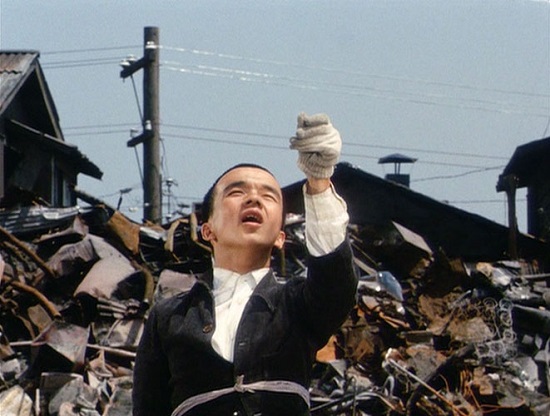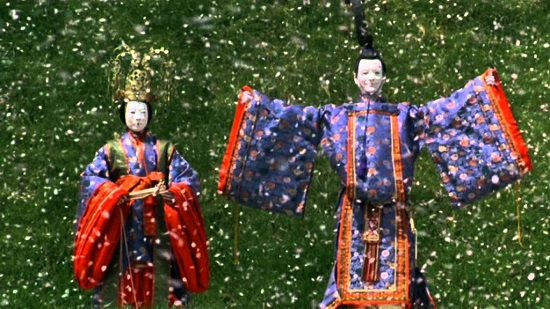Akira Kurosawa was reluctant to openly discuss his personal life. He felt, like many filmmakers and artists, that everything one might want to know about him is there within his work. In his book Something Like An Autobiography he only goes up to the point of Rashōmon in 1950, despite it being published in 1981. On this omission he says: "I think that to learn what became of me after Rashōmon the most reasonable procedure would be to look for me in the characters in the films I made after Rashōmon."
Doing exactly this is an interesting and essential process in understanding the great director. This was, after all, a period where he made a significant jump from the likes of Red Beard in 1965 to the bold and bizarre Dodes’ka-den (1971), the ethereal wonderland of Akira Kurosawa’s Dreams (1990) and of course Ran (1985). It was a period which aimed to answer many of the questions posed by the director earlier in his career and as such, despite often being ignored by retrospectives and collections, was a period which serves as a necessary conclusion to Kurosawa’s life.
In 1971 Akira Kurosawa tried to commit suicide. He was suffering from gall stones and failing eye site, but suffering more greatly from the failure of his recent films and their slide from cultural relevance in Japan. The film industry had started to drift away from him in the 1960s with a new wave of directors with new interests. In the immediate postwar period his moralistic and occasionally pedagogic tone were welcomed in a society which had lost its way, but by the late 1950s and 1960s and the accompanying affluence, such tales were not in high demand.
To make things worse, Kurosawa’s relationship with his brilliant, brooding and versatile lead actor Toshirô Mifune was strained to breaking point by Red Beard. Among other things, the film ran well behind schedule and prevented Mifune from pursuing a lucrative TV contract. After turning down Tora! Tora! Tora! Kurosawa instead formed his own production company with three others and called it The Four Musketeers.
This group were responsible for Dodes’ka-den, which could so easily have been the director’s last film. It follows a number of different stories from the underclass of society and shows us their unfolding woes and dreams as they attempt to escape through imagined worlds. The film opens and closes with a child pretending to drive a steam train through the rubble of the slums. He is abused and outcast for his apparent learning difficulties. Children throw rocks at him as they did a young Kurosawa. And yet, as an audience we are on his side: we are invited to join the child’s lonely imagination through the sound affects added by Kurosawa.
The film failed at the box office, the company folded and soon afterwards Kurosawa attempted to take his own life. The signs of a frustrated and lonely artist were clearly there in Dodes’ka-den, where creators and dreamers are ridiculed and ostracised. His suicide attempt of course failed, and, despite the dark notes surrounding this period, it came to represented an exciting new era for Kurosawa where he began to explore new ground and new themes.

Stephen Prince points out in The Warrior’s Camera that Kurosawa’s films made before 1965 had tended to depict empowered individuals with the ability to sculpt and reform society for the better. Yet, by Dodes’ka-den and continuing with Dersu Uzala, Kagemusha and Ran the individual instead presides over chaos and seems unable to impose their will on the world.
Kurosawa’s first film, Sanshiro Sugata, shows exactly this transition as an individual strives to master control of their environment through judo. Seven Samurai shows the collective skill of a cooperative group working to fend off oppression and liberate the defenceless villagers. Ran, made at the end of Kurosawa’s career, shows the stark contrast to this as a weary emperor wanders through a wilderness unable to grapple with his legacy, much as Kagemusha mocks the divine leader as a low criminal impersonates the clan chieftain and deceives his loyal followers.
Whilst these later films seem to represent the failure of human willpower, they do not suggest any sense of apathy from Kurosawa. When asked in an interview with Cineaste Magazine in 1986 why it was that his most recent films were more philosophical and less topical than the likes of The Bad Sleep Well and Scandal, Kurosawa replied: "I believe that the world would not change even if I made a direct statement: do this and do that. Moreover, the world will not change unless we steadily change human nature and our very own way of thinking. We have to exorcise the essential evil in human nature, rather than presenting concrete solutions to problems or directly depicting social problems. Therefore, my films might have become more philosophical."
This was clearly a director who was still adamant that cinema provided a tangible service to society in having the potential to change people’s views. He simply felt that film had to achieve this through emotion rather than instruction.
This change in tack makes sense when you see the stylistic changes to Kurosawa’s later films. Most obviously, he started to use colour. And not by halves either, but big splashes of bright primary colours across the fantasies of the slum dwellers in Dodes’ka-den, the costumes of warriors in Ran and the rainbows and blossom trees of Dreams. We’re allowed into the minds of his characters and even Kurosawa himself where we had only been allowed to observe and guess before.

Perhaps most significantly, these later films feel as if he has made peace with death, an ever present cloud over Kurosawa’s life and work which he had lived with since being a child of 13. He recalls in his autobiography gruesome memories following an earthquake in Japan: "I saw corpses charred black, half-burned corpses, corpses in gutters, corpses floating in rivers, corpses piled up on bridges…" The impression was one his brother Heigo forced to stick indelibly in his memory: "When I involuntarily looked away, my brother scolded me, ‘Akira, look carefully now… If you shut your eyes to a frightening sight, you end up being frightened. If you look at everything straight on, there is nothing to be afraid of.’"
Not only did his brother force Kurosawa to observe death, but he came to embody it when he himself committed suicide in 1933. He was a cinema narrator (a benshi) and had been leading the strikes at the time against the rise of the talkies which threatened his job. Kurosawa saw his brother covered in blood after he died and had to carry his corpse to the car with his father, before driving to the crematorium whilst it groaned as the body released air.
Film had played its part in taking Kurosawa’s brother’s life and so it became the medium through which he came to comprehend it. He had followed his brother’s advice and continued to stare and, by this late period in his career, had come to welcome death and not fear it. One of the brightest and most joyous scenes in all Kurosawa’s work comes in the funeral parade in Dreams where a local village celebrate death with songs and dancing.
Clearly by the end of his career Kurosawa had lost faith in the ability of society to change for the better as he saw it. Speaking to a magazine in 1980 he said: "If you look at the situation of the world around you, I think it’s impossible in this day and age to be optimistic." But importantly he had not lost hope in the individual. Speaking in the same interview he continued: "However, I feel that film as a medium has infinite possibilities… My attitude toward my work and my life is that I would like to be able to create hope somewhere."
Akira Kurosawa’s Dreams will be released by Criterion on the 15th of November


